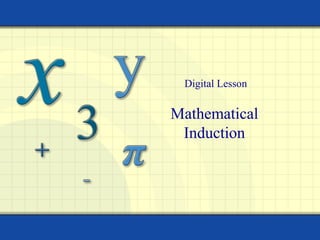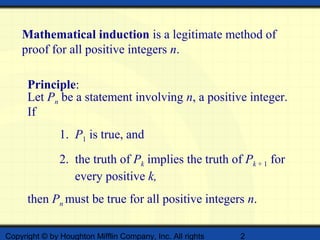1) Mathematical induction is a method of proof that can be used to prove statements for all positive integers. It involves showing that a statement is true for n=1, and assuming it is true for an integer k to prove it is true for k+1.
2) The document provides an example using mathematical induction to prove the formula Sn = n(n+1) for the sum of the first n even integers.
3) Finite differences are used to determine if a sequence has a quadratic model by seeing if the second differences are constant. The example finds the quadratic model n^2 for the sequence 1, 4, 9, 16, 25, 36.


![Copyright © by Houghton Mifflin Company, Inc. All rights 3
Example:
Find Pk + 1 for
3(2 1)
: .
1k k
k
P S
k
+
=
−
1 1
3[2( 1)
11
1]
:k kP S
k
k+ +
+ +
+
=
−
Replace k by k + 1.
Simplify.
3(2 2 1)k
k
+ +
=
3(2 3)k
k
+
= Simplify.](https://image.slidesharecdn.com/mathematicalinduction-150516065909-lva1-app6892/85/Mathematical-induction-3-320.jpg)

![Copyright © by Houghton Mifflin Company, Inc. All rights 5
Example continued:
Sk + 1 = 2 + 4 + 6 + 8 + . . .
+ 2k + [2(k + 1)]
= 2 + 4 + 6 + 8 + . . .
+ 2k + (2k + 2)
= Sk + (2k + 2) Group terms to form Sk.
= k(k + 1) + (2k + 2) Replace Sk by k(k + 1).
= k2
+ k + 2k + 2 Simplify.
= k2
+ 3k + 2
= (k + 1)(k + 2)
The formula Sn = n(n + 1) is valid for all positive integer
values of n.
= (k + 1)((k + 1)+1)](https://image.slidesharecdn.com/mathematicalinduction-150516065909-lva1-app6892/85/Mathematical-induction-5-320.jpg)


![Copyright © by Houghton Mifflin Company, Inc. All rights 8
3 2 2
2 3 6 12 6
6 6
k k k k k+ + + += + Simplify.
Example continued:
3 2
2 9 13 6
6
k k k+ + +=
2
( 3 2)(2 3)
6
k k k+ + +
=
( 1)( 2)(2 3)
6
k k k+ + +
=
( )[( ) 1][2(1 ) ]
6
1 11k k k+ + ++ +
=
The formula is valid for all positive
integer values of n.
( 1)(2 1)
6n
n n n
S
+ +
=](https://image.slidesharecdn.com/mathematicalinduction-150516065909-lva1-app6892/85/Mathematical-induction-8-320.jpg)


